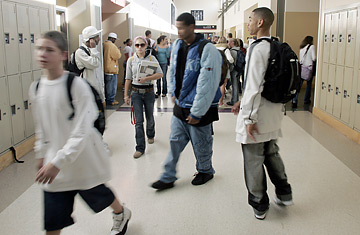
Students at Ballard High School in Seattle walk through the halls between classes. The Supreme Court on Thursday rejected integration plans in the Seattle and Louisville Kentucky, public school districts.
(2 of 2)
One common method uses students' socio-economic status. That usually means determining whether they qualify for the federal program offering free or reduced-price meals to low-income kids. In 2000, Wake County, North Carolina, stopped considering race and started making assignments so that, among other things, no more than 40% of any public school's students qualified for free or reduced-price meals, according to Walt Sherlin, the assistant school superintendent who implemented the plan. Today, student performance is way up — the plan's main objective — while the schools are still diverse. But Sherlin says diversity is a mere coincidence: black and Latino students are almost 10 times more likely than whites to qualify for free meals, meaning racial integration is a byproduct of economic integration.
Where poverty doesn't correlate closely with race, socio-economic status can be a bust. San Francisco stopped using race to assign students in 2001 and adopted a plan based in large part on economic factors like a students' eligibility for housing assistance or the free-meals program. Though the city's school district says it is "racially and culturally diverse" overall, it admits that its individual schools "have severely resegregated."
Other districts have maintained diversity by using race in indirect ways. Since 2004, Berkeley, Calif., has assigned students to public elementary schools based on their neighborhood's racial makeup and the income and education of its residents. The plan survived a legal challenge in April, though the case is on appeal. Variations in other cities consider a neighborhood's poverty level or opportunity index, which measures a broad range of factors that can correlate with race.
More entrepreneurial districts have used aggressive marketing—glossy brochures, marketing classes for principals — to recruit students for certain schools. That approach seems to have worked to maintain diversity at Montgomery County, Md., Lee County, Fla. and Duval County, Fla. schools, says Maree Sneed, an attorney who helped represent the Seattle School District in the case decided today. Magnet schools engage in a form of marketing by attracting students through special, often high-level, programs and classes. Their record is mixed at best on creating racial diversity.
Since the Supreme Court declared segregated schools "inherently unequal" in 1954, scholars have been arguing that students learn better in racially diverse classrooms, and five justices at least gave a nod to that view in today's opinions. But as Chief Justice Roberts, Justice Clarence Thomas in a concurring opinion and even Justice Breyer in dissent acknowledged, the evidence is mixed at best.
"Scholars have differing opinions as to whether educational benefits arise from racial balancing," Thomas wrote. "Some have concluded that black students receive genuine educational benefits. Others have been more circumspect. And some have concluded that there are no demonstrable educational benefits."
Despite the uncertainty, Breyer argues that the "Constitution allows democratically elected school boards to make up their own minds as to how best to include people of all races in one America."
Many will try things like relocating schools to minority neighborhoods or taking socio-economic status or neighborhood diversity into account, all measures endorsed by Justice Kennedy and at least mentioned by Chief Justice Roberts in today's opinions. But despite the court's apparent imprimatur, even those alternatives are not guaranteed to survive a future court challenge.
There's already been legal grumbling, for example, over plans that require state universities in Texas to accept for admission students who rank in a top percentage of their high school class. The idea is that at least some minorities will be in that percentage, allowing the state to create diversity without considering race.
But critics say the plans are mere proxies for affirmative action, serving no purpose other than to up minority representation among students. That makes them constitutionally suspect, argue the critics, a charge that could also be made against the various alternatives open to public school districts.
Today's decision should weaken that charge, but Mark Tushnet, a professor at Harvard Law School, says these issues may be the next legal battleground for school diversity. "School systems are going to try to achieve these (diversity) goals," he explains, "and they'll use proxies, and it will be litigated." And that means the Supreme Court will have yet another school integration case on its hands before we really know what schools can do to achieve "true racial equality."
